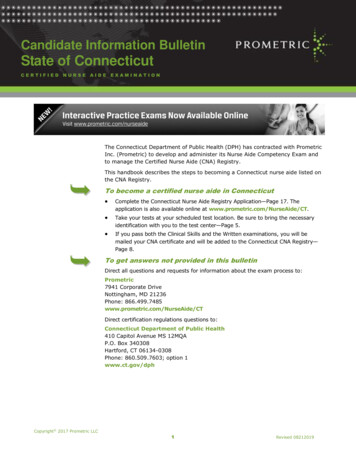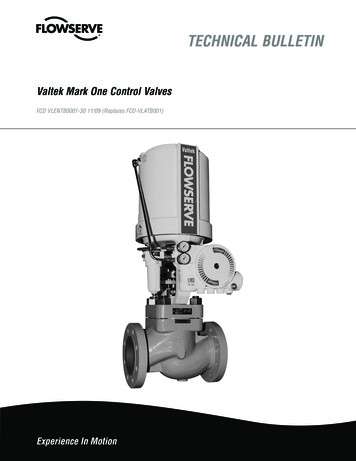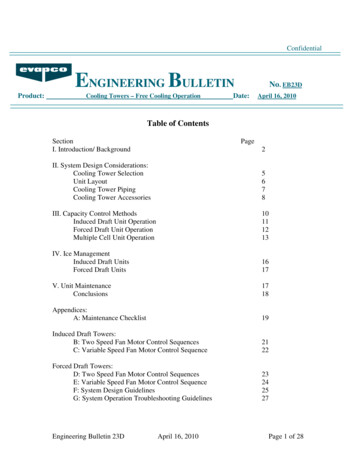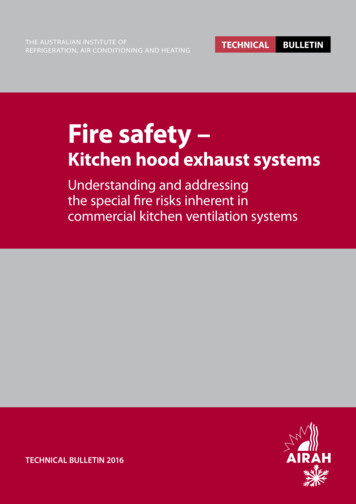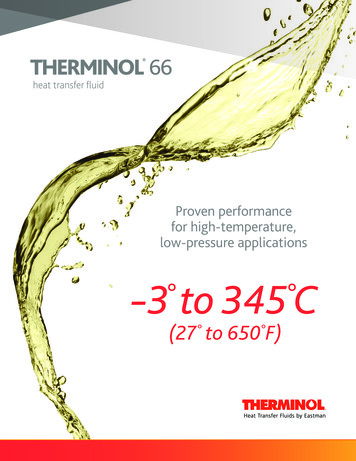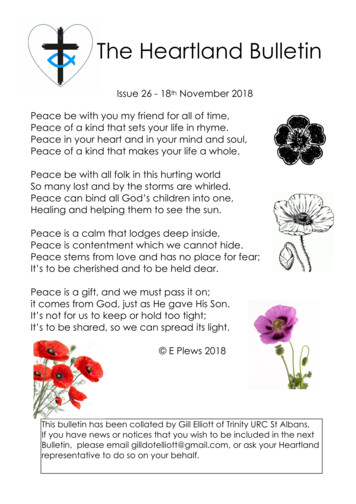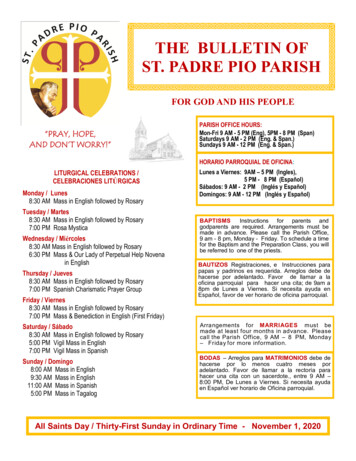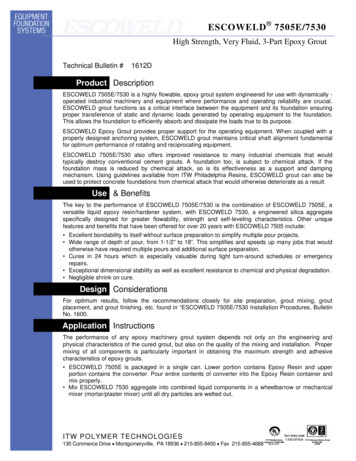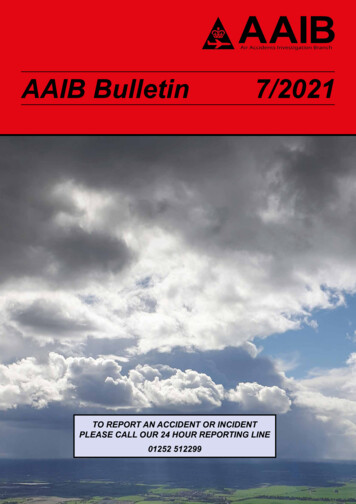
Transcription
AAIB Bulletin7/2021TO REPORT AN ACCIDENT OR INCIDENTPLEASE CALL OUR 24 HOUR REPORTING LINE01252 512299
Air Accidents Investigation BranchFarnborough HouseBerkshire Copse RoadAldershotHants GU11 2HHAAIB Bulletin: 7/2021GLOSSARY OF ABBREVIATIONSaalTel: 01252 510300Fax: 01252 376999Press enquiries: 0207 944 3118/4292http://www.aaib.gov.ukAAIB investigations are conducted in accordance withAnnex 13 to the ICAO Convention on International Civil Aviation,EU Regulation No 996/2010 (as amended) and The Civil Aviation(Investigation of Air Accidents and Incidents) Regulations 2018.The sole objective of the investigation of an accident or incident under theseRegulations is the prevention of future accidents and incidents. It is not thepurpose of such an investigation to apportion blame or liability.Accordingly, it is inappropriate that AAIB reports should be used to assign faultor blame or determine liability, since neither the investigation nor the reportingprocess has been undertaken for that purpose.AAIB Bulletins and Reports are available on the Internethttp://www.aaib.gov.ukThis bulletin contains facts which have been determined up to the time of compilation.Extracts may be published without specific permission providing that the source is duly acknowledged, the material isreproduced accurately and it is not used in a derogatory manner or in a misleading context.Published 8 July 2021Cover picture courtesy of Stephen R Lynn LRPS Crown copyright 2021Published by the Air Accidents Investigation Branch, Department for TransportPrinted in the UK on paper containing at least 75% recycled fibre(www.srlynnphotography.co.uk)ISSN (C)(O)ATISATPLBMAABGABBACBHPACAACAVOKCASccCGcmCPL AkgKCASKIASKTASkmktabove airfield levelAirborne Collision Avoidance SystemAutomatic Communications And Reporting SystemAutomatic Direction Finding equipmentAerodrome Flight Information Service (Officer)above ground levelAeronautical Information Circularabove mean sea levelAerodrome Operating MinimaAuxiliary Power Unitairspeed indicatorAir Traffic Control (Centre)( Officer)Automatic Terminal Information ServiceAirline Transport Pilot’s LicenceBritish Microlight Aircraft AssociationBritish Gliding AssociationBritish Balloon and Airship ClubBritish Hang Gliding & Paragliding AssociationCivil Aviation AuthorityCeiling And Visibility OK (for VFR flight)calibrated airspeedcubic centimetresCentre of Gravitycentimetre(s)Commercial Pilot’s LicenceCelsius, Fahrenheit, magnetic, trueCockpit Voice RecorderDigital Flight Data RecorderDistance Measuring Equipmentequivalent airspeedEuropean Union Aviation Safety AgencyElectronic Centralised Aircraft MonitoringEnhanced GPWSExhaust Gas TemperatureEngine Indication and Crew Alerting SystemEngine Pressure RatioEstimated Time of ArrivalEstimated Time of DepartureFederal Aviation Administration (USA)Flight Information RegionFlight Levelfeetfeet per minuteacceleration due to Earth’s gravityGlobal Positioning SystemGround Proximity Warning Systemhours (clock time as in 1200 hrs)high pressurehectopascal (equivalent unit to mb)indicated airspeedInstrument Flight RulesInstrument Landing SystemInstrument Meteorological ConditionsIntermediate PressureInstrument RatingInternational Standard Atmospherekilogram(s)knots calibrated airspeedknots indicated airspeedknots true d(s)low pressureLight Aircraft AssociationLanding Distance AvailableLicence Proficiency Checkmetre(s)millibar(s)Minimum Descent Altitudea timed aerodrome meteorological reportminutesmillimetre(s)miles per hourMaximum Total Weight AuthorisedNewtonsMain rotor rotation speed (rotorcraft)Gas generator rotation speed (rotorcraft)engine fan or LP compressor speedNon-Directional radio Beaconnautical mile(s)Notice to AirmenOutside Air TemperatureOperator Proficiency CheckPrecision Approach Path IndicatorPilot FlyingPilot in CommandPilot MonitoringPilot’s Operating HandbookPrivate Pilot’s Licencepounds per square inchaltimeter pressure setting to indicate heightabove aerodromealtimeter pressure setting to indicateelevation amslResolution AdvisoryRescue and Fire Fighting Servicerevolutions per minuteradiotelephonyRunway Visual RangeSearch and RescueService BulletinSecondary Surveillance RadarTraffic AdvisoryTerminal Aerodrome Forecasttrue airspeedTerrain Awareness and Warning SystemTraffic Collision Avoidance SystemTakeoff Distance AvailableUnmanned AircraftUnmanned Aircraft SystemUS gallonsCo-ordinated Universal Time (GMT)Volt(s)Takeoff decision speedTakeoff safety speedRotation speedReference airspeed (approach)Never Exceed airspeedVisual Approach Slope IndicatorVisual Flight RulesVery High FrequencyVisual Meteorological ConditionsVHF Omnidirectional radio Range
AAIB Bulletin: 7/2021CONTENTSSPECIAL BULLETINS / INTERIM REPORTSNoneSUMMARIES OF AIRCRAFT ACCIDENT (‘FORMAL’) REPORTSNoneAAIB FIELD INVESTIGATIONSCOMMERCIAL AIR TRANSPORTFIXED WINGNoneROTORCRAFTNoneGENERAL AVIATIONFIXED WINGNoneROTORCRAFTNoneSPORT AVIATION / BALLOONSNoneUNMANNED AIRCRAFT SYSTEMSNoneAAIB CORRESPONDENCE INVESTIGATIONSCOMMERCIAL AIR TRANSPORTAvro 146-RJ85Avro 652A Anson T21Bombardier BD700-1A10Cessna 310QReims Cessna AKA23-Jun-207-Sep-208-Dec-20303742GENERAL AVIATIONBoeing A75L300 StearmanCessna F177RGDA 42 NG Crown copyright 2021iAll times are UTC
AAIB Bulletin: 7/2021CONTENTS ContAAIB CORRESPONDENCE INVESTIGATIONS ContGENERAL AVIATION ContNicollier HN 700 Menestrel IIPioneer 300Piper PA-28-181Robinson R44 Clipper IStarduster Too SA300Vans 535960G-BXKM02-Apr-216419-Feb-202166SPORT AVIATION / BALLOONSRAF 2000 GTX-SEUNMANNED AIRCRAFT SYSTEMSParrot Anafi USAN/ARECORD-ONLY INVESTIGATIONSRecord-Only UAS Investigations reviewed:April / May 202173List of recent aircraft accident reports issued by the AAIB79MISCELLANEOUSADDENDA and CORRECTIONSNone(ALL TIMES IN THIS BULLETIN ARE UTC) Crown copyright 2021iiAll times are UTC
AAIB Bulletin: 7/2021AAIB Correspondence ReportsThese are reports on accidents and incidents whichwere not subject to a Field Investigation.They are wholly, or largely, based on informationprovided by the aircraft commander in anAircraft Accident Report Form (AARF)and in some cases additional informationfrom other sources.The accuracy of the information provided cannot be assured. Crown copyright 20211All times are UTC
AAIB Bulletin: 7/2021G-JOTRAAIB-27100ACCIDENTAircraft Type and Registration:Avro 146-RJ85, G-JOTRNo & Type of Engines:4 Lycoming LF507-1F turbofan enginesYear of Manufacture:1996 (Serial no: E2294)Date & Time (UTC):19 January 2021 at 1428 hrsLocation:London Biggin Hill Airport, KentType of Flight:Commercial Air Transport (positioning flight)Persons on Board:Crew - 5Passengers - NoneInjuries:Crew - NonePassengers - N/ANature of Damage:Front left fuselage puncturedCommander’s Licence:Airline Transport Pilot’s LicenceCommander’s Age:62 yearsCommander’s Flying Experience:10,618 hours (of which 5,761 were on type)Last 90 days - 76 hoursLast 28 days - 11 hoursInformation Source:Aircraft Accident Report Form submitted by thepilotThe crew boarded G-JOTR while it was parked on a taxiway, but airfield restrictions requiredit to be towed to a designated area on the apron for engine start (Figure 1). The towingroute followed the edge of the apron, which was damp and downhill, and involved a 90 leftturn to line up for start. A combination of unfamiliarity with a relatively new operating base,towing in reverse and difficulty interpreting “indistinct” taxiway markings meant the tug driverentered the left turn later than intended. The late entry made the turn excessively tight, andthe tug lost traction on the damp surface and jackknifed. The resulting combination of asharp towing angle and the aircraft’s downhill momentum caused the towbar shear pin tobreak. The commander applied the brakes immediately on hearing “the sound of snappingmetal” but was unable to prevent the aircraft rolling forward into the tug.The operator’s internal investigation report made several safety recommendations,including a review of towing procedures, enhanced driver training, the use of radios bytowing teams and improvements to taxiway markings. The company also reviewed itsapron risk assessment and towing was added to their audit plan. Crown copyright 20213All times are UTC
OFF‐SENAAIB Bulletin: 7/2021G-JOTRAAIB-27100Jackknifed tugFigure 1Approximate towing route and accident location(Image courtesy of Ordnance Survey 2021 TomTom)OFF‐SEN Crown copyright 20214All times are UTC
AAIB Bulletin: 7/2021G-VROEAAIB-26840SERIOUS INCIDENTAircraft Type and Registration:Avro 652A Anson T21, G-VROENo & Type of Engines:2 Armstrong Siddeley Cheetah 17 pistonenginesYear of Manufacture:1950 (Serial no: 3634)Date & Time (UTC):4 July 2020 at 1252 hrsLocation:Shobdon Aerodrome, Leominster, HerefordshireType of Flight:PrivatePersons on Board:Crew - 1Passengers - 1Injuries:Crew - NonePassengers - N/ANature of Damage:No damageCommander’s Licence:Private Pilot’s LicenceCommander’s Age:76 yearsCommander’s Flying Experience:7,642 hours (of which 69 were on type)Last 90 days - 18 hoursLast 28 days - 9 hoursInformation Source:Aircraft Accident Report Form submitted by thepilot and further enquiries by the AAIBSynopsisAfter encountering a gust of wind which displaced its final approach, the aircraft landedon unprepared ground beside the runway and completed its landing roll on an adjacenttaxiway, without reported damage or injury. In deciding to continue the landing the pilothad applied what he considered to be a cautious interpretation of information regarding theconduct of go-arounds in this aircraft.History of the flightThe aircraft had flown from Coventry Airport to Shobdon Aerodrome. At 1250 hrs,during the latter stage of its final approach to the grass Runway 26, the AerodromeFlight Information Service Officer (AFISO) transmitted landing information to the aircraft,including an ‘instant wind’ of 20 kt from 250 .The pilot stated that shortly before the aircraft reached the aerodrome boundary, a gust ofwind displaced it to the right. It subsequently landed on unprepared grass adjacent to therunway1. The aircraft completed its landing roll on grass Taxiway A (Figure 1).1The pilot reported the aircraft touched down ‘partially’ off the runway. Crown copyright 20215All times are UTC
AAIB Bulletin: 7/2021G-VROEAAIB-26840Grass Taxiway AGrass Runway 26Figure 1Extract from Shobdon’s Aerodrome Chart2Aerodrome informationShobdon’s Runway 26 is 810 m long and 30 m wide. The relevant entry in the AeronauticalInformation Publication (AIP) stated ‘Departure from the marked movement area can behazardous’.Aircraft informationThe Avro Anson T21 is a low-wing monoplane powered by two Cheetah Mk 17 engines, withtail wheel landing gear. It is operated by a single pilot.Weight and balanceThe ‘Pilot’s Notes Anson 19 & 21’ document, originally published by the Air Ministry, statedthe aircraft’s maximum weight for takeoff and gentle manoeuvres is 4,717 kg, and for landing(except in an emergency) is 4,581 kg3.The operator’s Organizational Control Manual (OCM)4 specified the aircraft’s centre ofgravity limits as 56.4 inches to 68 inches aft of datum.The pilot reported G-VROE’s basic weight for the incident flight was 3,413 kg and itscalculated landing weight was 3,792 kg. Its calculated centre of gravity (C of G) was57.7 inches aft.Footnote234From its Aerodrome Information Publication, published by NATS.The Pilots Notes specified these weights in lb.Operation of Permit-to-Fly Ex-Military aircraft on the UK register must occur in accordance with an approvedOCM (CAP 632 Edition 7 May 2018). Crown copyright 20216All times are UTC
AAIB Bulletin: 7/2021G-VROEAAIB-26840Information from the aircraft’s Pilot’s Notes documentThe Air Ministry’s ‘Pilot’s Notes Anson 19 & 21’ document contained guidance on ‘Goinground again’, including:‘At normal loads and C.G. positions, and trimmed for an engine-assistedapproach, the aircraft will climb away easily, with the undercarriage and flapsdown, at 80 to 90 knots Going round again from a glide approach, especially when loaded to a forwardC.G. position, will prove difficult if the airspeed is allowed to fall below 70 knotsbefore the decision to go round again is made, since the strong nose-upchange of trim, induced by opening the throttles fully, may prove excessive. It isrecommended, therefore, that the aircraft be trimmed progressively nose-downas power is increased With the C.G. at the aft limit, it may be impossible to overcome the nose-upchange of trim.’Regarding ‘Going round again on one engine’ the Pilot’s Notes stated:‘The decision to overshoot must be made at a minimum of 600 feet above theground and before flap has been selected ’Additional information from the pilotThe pilot stated that he interpreted the Pilot’s Notes document as cautioning against “late”go-arounds ‘because the application of full power may produce an uncontrollable changein elevator force’, and that a decision to “commit” to landing is required when final flap andtrim settings are selected.He stated that a lateral adjustment in G-VROE to compensate for the gust would haveresulted in a crabbed touchdown and possible ground loop5. Consequently, he opted toland on the grass beside the runway. He felt confident that the landing surface was safe,and there was no other traffic nearby.Additional information from the aerodrome operatorThe AFISO reported that during the time G-VROE made its approach to Shobdon therewere no other aircraft in the air or manoeuvring on the ground, but that some aircraft wereparked in both of the aircraft parking areas (Figure 1). He had flown himself that day andrecalled the wind being “a bit gusty”.He reported that, because of his viewing angle, it was only in the “last few seconds” thathe noticed the aircraft appeared aligned with Taxiway A, rather than grass Runway 26;Footnote5Ground loop – significant (usually unintended) yawing of an aircraft on the ground when the yaw is notopposed by effective control inputs or other stabilising forces. Crown copyright 20217All times are UTC
AAIB Bulletin: 7/2021G-VROEAAIB-26840and that he did not have time to alert the pilot. He recalled the aircraft touched down onTaxiway A and turned right onto Taxiway C.The AFISO recalled previous occasions where aircraft inadvertently approached grassTaxiway A, rather than the adjacent grass runway surface, and went around. As a resultof such an approach to grass Runway 08 he had submitted a ‘Local hazard report’6. Therunway numbers were subsequently re-painted.Information from the operatorThe OCM stated:‘The Anson should not be operated from airfields with less than 750 metres oftake-off and landing distance available. The aircraft can easily be operatedfrom grass runways, and in those cases the minimum runway length will be900 metres. Operations of the Anson into airfields with less than that statedmust be briefed and approved by the Chief Pilot.’AnalysisThe pilot reported that while approaching the aerodrome boundary a gust of wind causedthe aircraft to drift to the right. He believed he was “committed” to landing the aircraft afterselecting final flap and trim, and that making a lateral adjustment to its flight path wouldcause handling difficulties after touchdown. Therefore, he landed the aircraft partially onthe grass beside the runway, and completed the landing roll on the adjacent taxiway.The Anson Pilot’s Notes described circumstances in which a go-around should not beattempted. Although the pilot applied what he considered a cautious interpretation of thatguidance, the Pilot’s Notes indicated that G-VROE’s configuration, weight and balanceon this occasion would not have precluded a go-around from an engine-assisted finalapproach.The investigation did not determine why the aircraft completed its landing roll further righton Taxiway A, rather than returning to the runway. It also did not determine the nature ofthe operator’s briefing and approval process for operating G-VROE on Shobdon’s grassRunway 26, which was 90 m shorter than the relevant minimum runway length specified byits OCM.Shobdon’s AIP stated that manoeuvring outside the ‘marked movement area can behazardous’. The pilot believed that continuing with the landing was the safest course ofaction, and that the landing surface was safe, with no obvious obstacles or traffic nearby.Footnote6‘Local Hazard Report’ – the aerodrome operator’s internal safety report, which is part of its safety managementsystem. Crown copyright 20218All times are UTC
AAIB Bulletin: 7/2021G-VROEAAIB-26840ConclusionThe runway excursion occurred because the aircraft was not aligned with the runwayon landing. The conditions in which the aircraft’s operating manual cautioned againstgoing around were not present during the incident approach, but the pilot applied whathe considered to be a cautious interpretation of the guidance, believing that adjusting theaircraft’s flight path would cause handling difficulties after touchdown. Crown copyright 20219All times are UTC
AAIB Bulletin: 7/2021CS-GLDAAIB-26949SERIOUS INCIDENTAircraft Type and Registration:Bombardier BD700-1A10, CS-GLDNo & Type of Engines:2 BR700-710A2-20 Turbofan enginesYear of Manufacture:2014 (Serial no: 9538)Date & Time (UTC):17 September 2020 at 1145 hrsLocation:Biggin Hill Airport, KentType of Flight:Commercial Air Transport (Non-Revenue)Persons on Board:Crew - 4Passengers - NoneInjuries:Crew - NonePassengers - N/ANature of Damage:Abrasion of wing tip, flap, aileron, and canoefairingsCommander’s Licence:Airline Transport Pilot’s LicenceCommander’s Age:50 yearsCommander’s Flying Experience:7,334 hours (of which 2,422 were on type)Last 90 days - 55 hoursLast 28 days - 25 hoursInformation Source:Aircraft Accident Report Form submitted by thepilotSynopsisThe aircraft was on a positioning flight from Edinburgh Airport to Biggin Hill Airport in Kentand, having completed a circle-to-land procedure, carried out the final approach to land.The aircraft was fully configured for landing, established at the approach airspeed of VREF1with the autothrottle engaged but being ‘hand flown’ by the pilot. There was a crosswindcomponent from the right.During the flare, a large amount of right rudder and right roll control was applied with theaircraft in a high nose-up attitude, causing a roll to the right. Although the roll was counteredimmediately with a large application of opposite roll control, the aircraft touched down beforethis input took effect, and the combination of nose-up pitch attitude and right wing downcaused the wingtip to contact the runway.The landing technique just before touchdown was not in accordance with the manufacturer’scrosswind landing technique. However, a simulation by the manufacturer showed that theroll rate achieved was not accounted for by roll control alone, and it appeared likely that itwas increased by localized wind or gust effects.Footnote1VREF for the Global 6000 was calculated during certification as 1.326 x VSMIN, where VSMIN is the nong-corrected stick pusher activation speed. Crown copyright 202110All times are UTC
AAIB Bulletin: 7/2021CS-GLDAAIB-26949History of the flightGeneralThe flight crew were working a week on, week off roster and were on the third day of theirweek on. They had arrived at Biggin Hill Airport on 15 September 2020 and the followingday had positioned the aircraft to Northolt Airport, where passengers were boarded andflown to Edinburgh Airport. The third sector that day was from Edinburgh to East MidlandsAirport where the crew stayed overnight in a hotel. On the day of the incident, the crew flewfrom East Midlands to Edinburgh before positioning back to Biggin Hill. The flight crew flewalternate sectors as Pilot Flying (PF) or Pilot Monitoring (PM).The incident flightThe incident flight departed Edinburgh at 1046 hrs to position to Biggin Hill with the co-pilotas the PF and the commander as the PM. There were two cabin crew and no passengers.The weather conditions reported on the METAR at Biggin Hill at 1150 hrs gave the surfacewind as from 060 at 15 kt, visibility in excess of 10 km with FEW clouds at 3,400 ft, OAT18 C, dew point 9 C, and QNH 1029 hPa. This meant that Runway 032 was in use and,as there was no instrument approach to that runway, an ILS approach to Runway 21 wasmade, followed by a circle-to-land procedure onto Runway 03, which the crew had plannedfor in their pre-flight briefing. The transit was uneventful, and the normal briefing and checkswere carried out. The circle-to-land procedure was flown, and a VREF for the final approach of117 kt was calculated using the Flight Management System. Airspeed during the procedurewas 126 kt, and the autopilot was engaged until the base leg, with the autothrottle remainingengaged for the landing.The commander, as the PM, used the Head Up Display (HUD) for the approach inaccordance with the Standard Operating Procedures. No gusts had been reported, andwith the Runway 03 PAPIs set to 4 , no increments to VREF were added.The aircraft was configured for the final approach with slats 20 and flaps 30 selectedand was flown with a VREF of 117 KIAS as the approach speed. The PM noticed that theunsteady wind caused the airspeed to vary, momentarily dropping below VREF, but thenincreasing back to VREF, which was maintained within /- 2 kt. As the aircraft passed overa valley just before the runway threshold, the airspeed increased to 8 kt above VREF, butwas reduced again over the next 12 seconds. As they passed over the runway threshold,ATC passed the surface wind as 070 at 12 kt, with the aircraft heading between 033 and036 to compensate for the crosswind from the right. At 50 ft over the runway threshold,the auto throttles retarded and the PM thought that the airspeed seemed to drop rapidly.At a height of 10 ft the airspeed was 5 kt below VREF, and after passing the displacedthreshold it had reduced to 10 kt below VREF. The PM thought that the pitch attitudeseemed higher than normal and was monitoring the Flightpath Vector (FPV) through theHUD, as it provided a sense of where the aircraft was in the flare. Just before touchdown, the bank angle increased rapidly to the right in response to control inputs, and theFootnote2Runway 03 has a magnetic heading of 026 M and threshold elevation of 577 ft amsl. Crown copyright 202111All times are UTC
AAIB Bulletin: 7/2021CS-GLDAAIB-26949PF positively applied left roll to correct it. However, at a height of one foot, the airspeedwas 10 kt below VREF, nose-up pitch was 9 and there was an angle of bank to the rightof 8.5 . As the right main landing gear touched down, the right wingtip contacted therunway. After the landing roll was completed, the aircraft was taxied to the parking areaunder its own power.Recorded informationThe aircraft was fitted with an FDR and CVR which were downloaded at the AAIB. Bothrecorders captured the landing event.At 1145:01 hrs, the aircraft reached 50 ft radio altitude (RA) (Figure 1, point A) with anindicated airspeed of 114 kt and a magnetic heading of 035.4 . The onboard derived windwas a 16.8 kt crosswind from the right.Two seconds later the aircraft passed through a RA of 30 ft (point B) at an airspeed of109 kt. The control column was moved progressively aft, with a corresponding increasein aircraft attitude to 9.1 nose up. The aircraft started rolling left (point C) reachinga maximum bank angle of 4.4 left wing down at a RA of 20 ft. As the aircraft startedrolling left, the control wheel was moved to a 34.7 right roll command, reducing to24.2 1.3 seconds later, along with right rudder pedal producing a rudder deflection of7.4 to the right. Within this time frame, the aircraft started rolling back to wings level,and the right multifunction spoiler had started to deploy, reaching 5 deflection, where itremained for 1.5 seconds before returning to the retracted position. A data plot of therelevant parameters is shown at Figure 1.Half a second before touchdown (point D), the roll rate increased to a peak of 14.3 /s rightwing down, to which a control wheel input was made to 62.1 left wing down. The right mainlanding gear touched down first with the aircraft at its peak roll attitude of 8.5 to the rightand a pitch attitude of 9.1 nose-up. The aircraft then rolled to the left as the pitch continuedto increase to a peak of 10.5 nose-up a second later.Manufacturer’s analysisData was sent to the aircraft manufacturer who provided an interpretation of the landingphase. Of significance was the assessment of the yaw damper operation, which was:‘Until the aircraft reached a height of 30 ft radio altimeter, rudder deflectionranged between 5.2 trailing edge right to 4.9 trailing edge left. The yawdamper was engaged, and the range of rudder deflection was consistent withyaw damper nominal authority of /- 6.5 with no rudder pedal movement’. Crown copyright 202112All times are UTC
AAIB Bulletin: 7/2021CS-GLDAAIB-26949Figure 1CS-GLD FDR parametersAircraft descriptionGeneralThe Global 6000 is a long-range business jet variant of the Bombardier Global Expressaircraft. It is designed to accommodate a crew of 2 to 4 persons and 8 to 10 passengers in abusiness configuration, or up to 19 passengers in a high density configuration, at a cruisingspeed of Mach 0.89, up to 51,000 ft, over a range of 6,000 nm. A two-pilot flight deck isequipped with four large Adaptive Flight Display units, and a HUD on the commander’s sideonly. Crown copyright 202113All times are UTC
AAIB Bulletin: 7/2021CS-GLDAAIB-26949The aircraft dimensions are shown at Figure 2:Figure 2The aircraft dimensionsThe flight control systemThe Global 6000 flight control system comprises primary and secondary flight controls. Theprimary flight controls are responsible for the roll, pitch and yaw attitudes of the aircraft. Rollcontrol is achieved through the use of ailerons, pitch control is achieved by the elevators,and yaw control is achieved by the rudder. Manual inputs from the flight crew, autopilot,or trim actuator move cables and control rods, which reposition servovalves on the flightcontrol Power Control Units. Hydraulic pressure then moves the control surfaces to thedesired position.The secondary flight controls include lift-altering devices of leading edge slats and trailingedge flaps, which alter the wing profile, providing increased lift at low airspeeds for takeoff,landing and during low-speed flight, such as a circle-to-land manoeuvre. Multifunctionspoilers deploy in the roll assist mode in response to control wheel inputs, and in the liftdumping mode in response to flight spoiler control lever input. Automatic lift dumping isprovided on landing by ground spoilers combined with multifunction spoilers. In addition,a yaw damper provides stability augmentation about the yaw axis and assists with turncoordination. Crown copyright 202114All times are UTC
AAIB Bulletin: 7/2021CS-GLDAAIB-26949The engines can be controlled using manual throttle levers or an autothrottle system. Onlanding with autothrottle engaged, the autothrottle will retard the engines to idle at 50 ft agl.The Flight Crew Operating Manual (FCOM) states that, ‘As soon as the thrust is reducedto idle, the airplane will decelerate. Touchdown at approximately VREF -4 kts is reasonable’.The manufacturer also stated that:‘As the thrust is reduced (including spool down time), the airplane starts slowingdown. This slow down (over the course of 5 to 7 seconds) will result in theoptimal touch down speed and attitude. Speed loss is expected to be 2 to 4%from that at thrust reduction (4 to 7 kts)’.Landing techniqueThe manufacturer’s technique for landing the aircraft with a crosswind component is set outin the FCOM, which states:‘Crosswind LandingThe recommended technique for approach is a wings level crab techniquewhere the aircraft is pointed into wind to control direction. If a crosswind ispresent, as the flare is commenced, application of rudder is used to align thefuselage parallel with the runway centreline.As rudder is applied the aircraft will tend to roll in the direction of the rudder input.To counter this, simultaneous input of rudder and opposite aileron is required tokeep the wings level. In this wings level condition, there will be some sidewaysdrift. A slight, into wind, wing down should control this sideways motion.Excessive wing down can cause the wingtip to contact the runway. In order tominimize this possibility, the bank should be limited to less than 3 degrees andthe touchdown should occur as soon as the aircraft is aligned with the runway.Prolonging the flare would increase the pitch attitude which brings the wingtipcloser to the ground.The aileron input is required throughout the landing roll and the input should beincreased as the airspeed decreases.Any lateral motion on final approach should be controlled using aileron inputs.The rudder should not be used to control lateral motion and should only beused in the flare to align the aircraft with the runway. The use of autobrake isrecommended with strong crosswinds.’A diagram provided by the manufacturer illustrating the relationship between nose-uppitch and wingtip clearance is shown at Figure 3, along with the angle of bank at whichthe tip will contact the runway (with the wing on the ground but not producing lift (JIG),and in flight). Crown copyright 202115All times a
FIR Flight Information Region FL Flight Level ftfeet ft/min feet per minute . LAA Light Aircraft Association LDA Landing Distance Available LPC Licence Proficiency Check . Shobdon’s Runway 26 is



